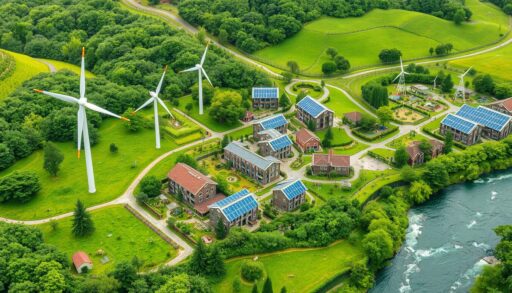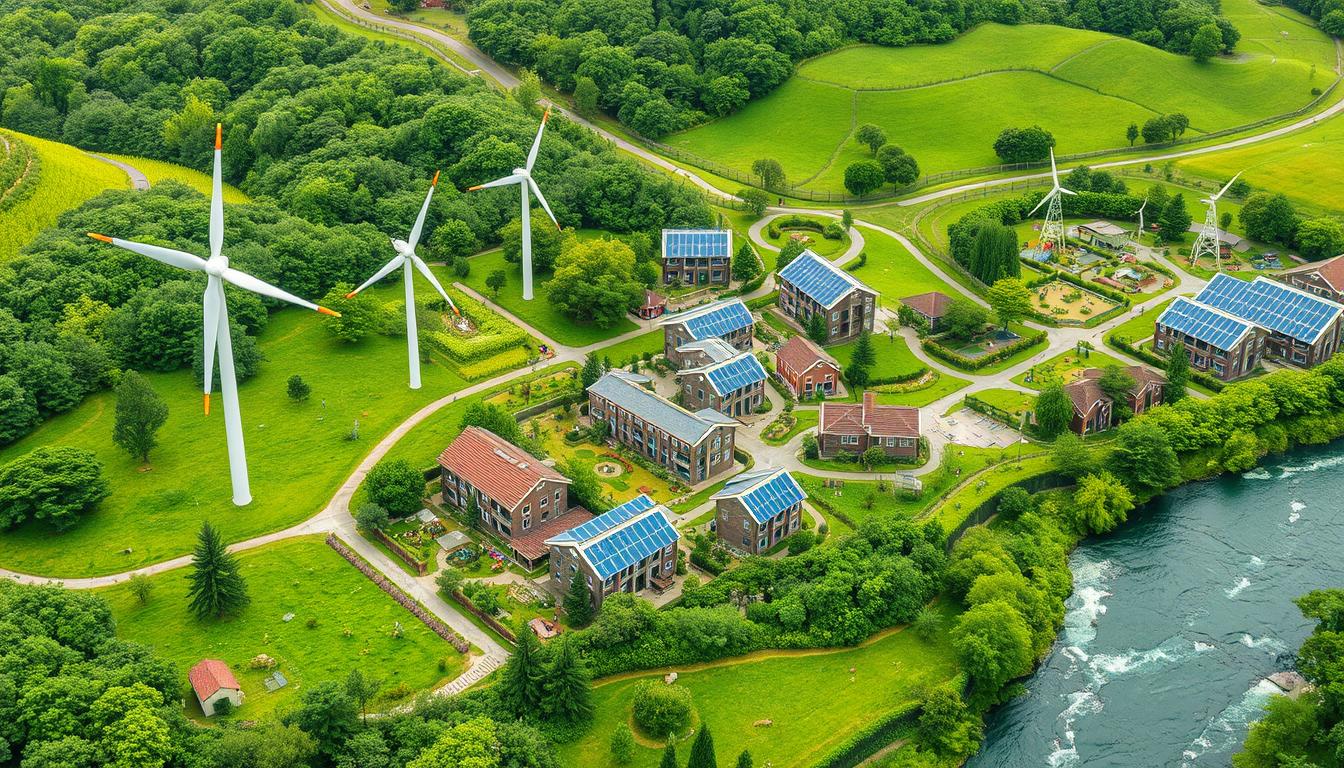Sustainable development meets today’s needs without harming tomorrow’s. It’s about finding a balance between growing the economy, improving society, and protecting nature. This approach is key to solving big global problems like climate change and poverty.
By choosing sustainable ways, we can make a world that’s fair, strong, and kind to our planet. It’s crucial for growing the economy in a way that’s good for everyone and the environment. This ensures a brighter future for all of us.
Key Takeaways
- Sustainable development is a holistic approach that balances economic, social, and environmental considerations.
- It aims to address global challenges such as climate change, biodiversity loss, poverty, and inequality.
- Adopting sustainable practices can create a more equitable, resilient, and environmentally-friendly world.
- The 2030 Agenda for Sustainable Development, adopted by the United Nations, outlines 17 ambitious goals to be achieved by 2030.
- Sustainable development requires a collaborative effort involving multiple stakeholders and a focus on sustainable financing and innovation.
Understanding Sustainable Development
Sustainable development is a key concept aimed at solving our world’s big challenges. It means meeting today’s needs without harming tomorrow’s chances. This approach balances economic growth, social progress, and protecting the environment for a better future.
Definition and Objectives of Sustainable Development
The main goals of sustainable development are to end poverty, protect the environment, and promote social and economic growth. It aims to make our world fair, prosperous, and green for everyone.
The Three Pillars: Economic, Social, and Environmental
The three main parts of sustainable development are economic growth, social progress, and environmental protection. These parts work together and support each other. Balancing them is key to a sustainable world.
For instance, the United Nations Sustainable Development Goals (SDGs) set in 2015 offer a detailed plan for sustainable development. These 17 goals tackle many issues, from fighting poverty and improving education to tackling climate change and promoting responsible consumption.
| Economic Pillar | Social Pillar | Environmental Pillar |
|---|---|---|
| Inclusive and sustainable economic growth | Poverty eradication and social inclusion | Sustainable management of natural resources |
| Sustainable production and consumption | Quality education and decent work | Biodiversity conservation and ecosystem protection |
| Sustainable infrastructure development | Gender equality and women’s empowerment | Climate change mitigation and adaptation |
Understanding sustainable development’s definition, goals, and pillars helps us strive for a better, more equal future for everyone.
The 17 Sustainable Development Goals
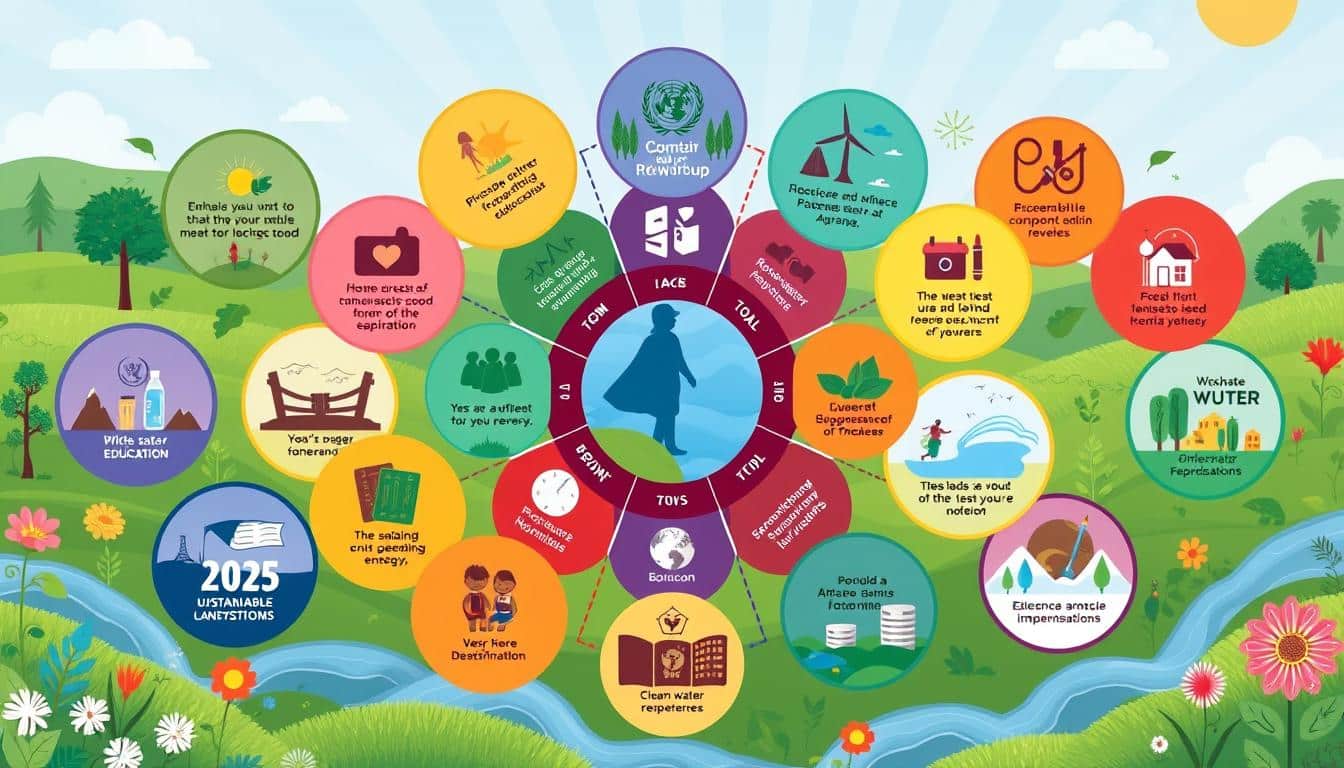
In 2015, all United Nations member states agreed on the 17 Sustainable Development Goals (SDGs). These goals aim for peace, prosperity, and a healthy planet. They tackle big issues like poverty, hunger, education, gender equality, and clean energy.
The 17 SDGs are:
- No Poverty
- Zero Hunger
- Good Health and Well-Being
- Quality Education
- Gender Equality
- Clean Water and Sanitation
- Affordable and Clean Energy
- Decent Work and Economic Growth
- Industry, Innovation, and Infrastructure
- Reduced Inequalities
- Sustainable Cities and Communities
- Responsible Consumption and Production
- Climate Action
- Life Below Water
- Life on Land
- Peace, Justice, and Strong Institutions
- Partnerships for the Goals
To reach the SDGs, we need a global effort. It’s about improving health, education, and the economy while tackling the environment. The High-level Political Forum on Sustainable Development tracks our progress.
But, achieving the SDGs by 2030 seems unlikely. Inequalities, climate change, and biodiversity loss are big hurdles. The COVID-19 pandemic has made things even harder. Yet, the SDGs guide us towards a better future for everyone.
History and Evolution of Sustainable Development
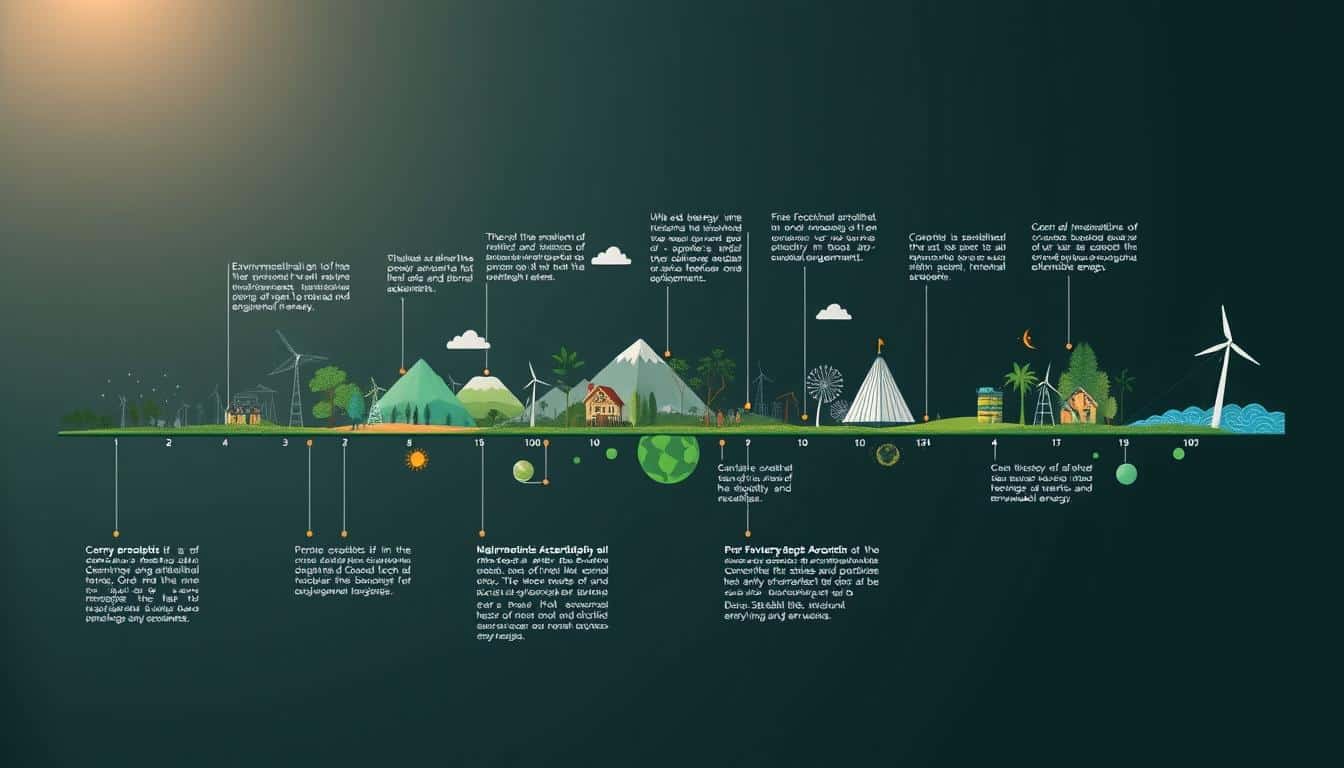
The idea of sustainable development has grown over many years. In 1992, the Earth Summit in Rio de Janeiro was a big step. It led to Agenda 21, a plan for global partnership in sustainable development.
More than 100 leaders and 178 countries were there. So were many civil society groups.
The roots of sustainable development go back even further. The Brundtland Commission’s 1987 report, “Our Common Future,” highlighted environmental concerns. Before that, the 1972 United Nations Conference in Stockholm started the conversation on managing development and the environment together.
The 2002 World Summit on Sustainable Development in Johannesburg reaffirmed global commitments. It focused on sustainable consumption, water, sanitation, and energy. Leaders from 191 countries, UN agencies, and other groups attended.
The journey to the Sustainable Development Goals (SDGs) began at the 2012 Rio+20 Conference. The SDGs were adopted in 2015 as part of the 2030 Agenda. They build on the Millennium Development Goals (MDGs) and tackle economic, social, and environmental challenges together.
This shows the world’s growing need for a holistic approach to sustainable development. It addresses climate change, biodiversity loss, and inclusive economic growth. The United Nations and its member states see sustainable development as a key priority.
Sustainable Development

Sustainable development is a way to meet today’s needs without harming tomorrow’s. It focuses on three main areas: economic growth, social progress, and protecting the environment. This approach aims to make the world more fair, strong, and green.
The Sustainable Development Goals (SDGs) were set by the United Nations in 2015. They are 17 goals to tackle big issues like poverty, inequality, and climate change. The goals aim to be met by 2030, promoting growth, education, and protecting the planet.
To reach the SDGs, everyone must work together. This includes governments, businesses, and individuals. We need to adopt sustainable practices and support new technologies. Together, we can build a better future for all.
But, achieving sustainable development is tough. We face big challenges like climate change and inequality. Yet, with a shared goal, we can make a big difference.
Sustainable development is more than a dream; it’s a must for our planet’s future. By adopting green practices and striving for the SDGs, we can ensure a prosperous and fair world.
Environmental Challenges and Sustainable Solutions
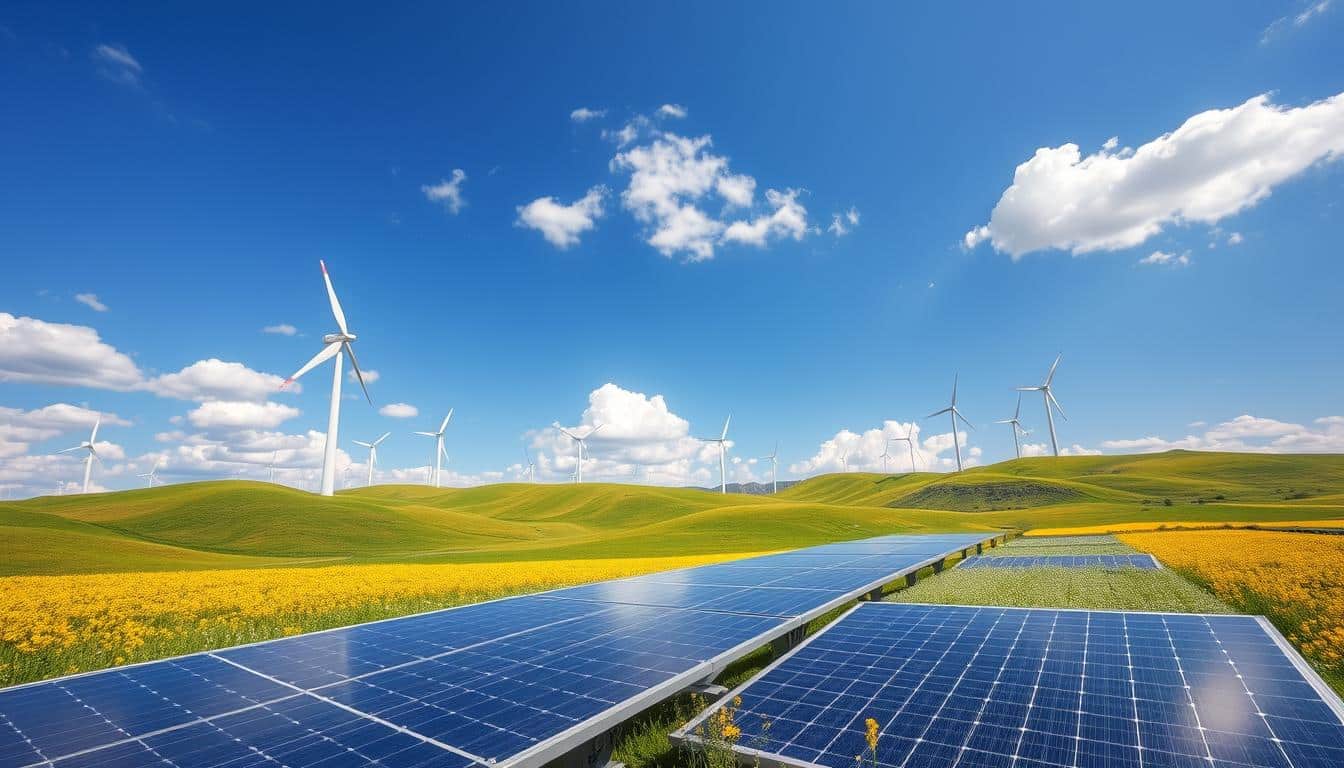
The world faces big challenges like climate change and losing biodiversity. Sustainable development is key to solving these problems. The Sustainable Development Goals (SDGs) were adopted in 2015. They aim to make our world sustainable for people and the planet.
Climate Change and Sustainable Energy
Climate change is a big threat because of human actions. Switching to sustainable energy is crucial. The European Union wants to be carbon neutral by 2050 with the European Green Deal.
Biodiversity Loss and Ecosystem Protection
Biodiversity loss and damaged ecosystems are serious threats. We need to protect natural habitats and use sustainable agriculture and forestry. The Sustainable Development Goals focus on these issues, aiming to save our oceans and ecosystems.
Using sustainable practices is vital for the Sustainable Development Goals. By working together, we can make a better world for all. This includes finding new solutions and living more sustainably.
“Sustainable development is development that meets the needs of the present without compromising the ability of future generations to meet their own needs.” – The Brundtland Commission
| Environmental Challenge | Sustainable Solutions |
|---|---|
| Climate Change |
|
| Biodiversity Loss |
|
Economic and Social Dimensions of Sustainable Development
Sustainable development is more than just saving the environment. It also focuses on economic and social growth. The United Nations’ Sustainable Development Goals (SDGs) aim to end poverty and ensure everyone benefits from growth. They target reducing inequality, improving education, and creating good jobs.
Poverty Eradication and Inclusive Growth
Economic growth must include everyone, not just a few. This means creating jobs and opportunities for all. The SDGs aim to end poverty by 2030, showing a global commitment to fairness and equality.
Quality Education and Decent Work
Quality education and good jobs are key to sustainable development. Education prepares people for the future and helps the economy grow. Good jobs, with fair pay and safety, build strong and fair societies. These goals are at the heart of the SDGs, showing a complete approach to development.
Also Red : Clean Technology: Transforming Industries For Sustainable Growth
FAQs
Q: What is sustainable development and why is it important?
A: Sustainable development is a holistic approach to growth that seeks to meet the needs of the present without compromising the ability of future generations to meet their own needs. It is important because it promotes a balance between economic growth, environmental stewardship, and social inclusion, ensuring a better quality of life for all.
Q: What are the 17 SDGs?
A: The 17 SDGs, or Sustainable Development Goals, are a set of global goals adopted by all United Nations member states in 2015 as part of the 2030 Agenda for Sustainable Development. They aim to address various global challenges, including poverty, inequality, climate change, environmental degradation, peace, and justice.
Q: How do the global goals relate to sustainable development?
A: The global goals, also known as the SDGs, provide a framework for promoting sustainable development. They encompass a range of targets and indicators designed to guide nations in achieving a sustainable future while addressing economic growth, social inclusion, and environmental protection.
Q: What role does education for sustainable development play in achieving the SDGs?
A: Education for sustainable development is crucial as it equips individuals with the knowledge, skills, and values necessary to contribute to sustainable development. It fosters critical thinking and empowers people to make informed decisions that promote sustainable practices in their communities.
Q: What is the significance of partnerships for the goals?
A: Partnerships for the goals emphasize collaboration among governments, civil society, the private sector, and other stakeholders to achieve the SDGs. The global partnership for sustainable development is essential for mobilizing resources, sharing knowledge, and coordinating efforts to address complex global challenges.
Q: How is economic growth linked to sustainable development?
A: Economic growth is an essential component of sustainable development, as it can provide resources for improving living standards, reducing poverty, and investing in infrastructure. However, it must be pursued in a way that is environmentally sustainable and socially inclusive to truly benefit society.
Q: What are the goals and targets associated with the SDGs?
A: Each of the 17 SDGs has specific goals and targets that outline measurable outcomes to be achieved by 2030. These targets cover a wide range of issues, such as promoting sustainable consumption and production, ensuring full and productive employment, and fostering sustainable forest management.
Q: How can nations contribute to the global sustainable development report?
A: Nations can contribute to the global sustainable development report by collecting and sharing data related to their progress on the 17 SDGs. This involves monitoring and evaluating their development agenda, reporting on achievements, and identifying areas needing improvement to enhance global efforts towards sustainable development.
Q: What was the purpose of the United Nations Conference on Sustainable Development?
A: The United Nations Conference on Sustainable Development, also known as Rio+20, aimed to renew global commitment to sustainable development. It provided a platform for discussing the post-2015 development agenda and led to the adoption of the 17 SDGs as a guiding framework for future initiatives.

